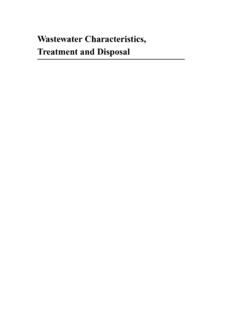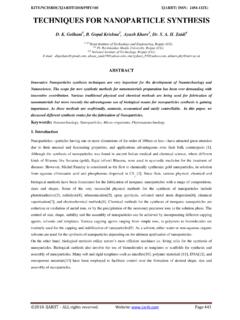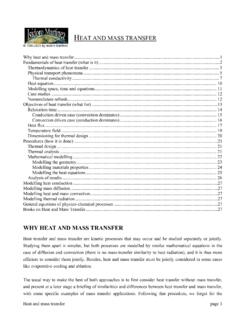Transcription of Basic Principles of Wastewater Treatment
1 Basic Principles ofWastewater TreatmentBiological Wastewater Treatment SeriesTheBiological Wastewater Treatmentseries is based on the bookBiologicalWastewater Treatment in Warm Climate Regionsand on a highly acclaimed set ofbest selling textbooks. This international version is comprised by six textbooksgiving a state-of-the-art presentation of the science and technology of biologicalwastewater in theBiological Wastewater Treatmentseries are:Volume 1: Wastewater Characteristics, Treatment and DisposalVolume 2: Basic Principles of Wastewater TreatmentVolume 3:Waste Stabilisation PondsVolume 4:Anaerobic ReactorsVolume 5:Activated Sludge and Aerobic Biofilm ReactorsVolume 6:Sludge Treatment and DisposalBiological Wastewater Treatment SeriesVOLUME TWOB asic Principles ofWastewater TreatmentMarcos von SperlingDepartment of Sanitary and Environmental EngineeringFederal University of Minas Gerais, BrazilPublished by IWA Publishing, Alliance House, 12 Caxton Street, London SW1H 0QS, UKTelephone: +44 (0) 20 7654 5500; Fax: +44 (0) 20 7654 5555; Email: published 2007C 2007 IWA PublishingCopy-edited and typeset by Aptara Inc.
2 , New Delhi, IndiaPrinted by Lightning SourceApart from any fair dealing for the purposes of research or private study, or criticism or review, aspermitted under the UK Copyright, Designs and Patents Act (1998), no part of this publication maybe reproduced, stored or transmitted in any form or by any means, without the prior permission inwriting of the publisher, or, in the case of photographic reproduction, in accordance with the terms oflicences issued by the Copyright Licensing Agency in the UK, or in accordance with the terms oflicenses issued by the appropriate reproduction rights organization outside the UK. Enquiriesconcerning reproduction outside the terms stated here should be sent to IWA Publishing at theaddress printed publisher makes no representation, expressed or implied, with regard to the accuracy of theinformation contained in this book and cannot accept any legal responsibility or liability for errors oromissions that may be information provided and the opinions given in this publication are not necessarily those of IWAor of the editors, and should not be acted upon without independent consideration and professionaladvice.
3 IWA and the editors will not accept responsibility for any loss or damage suffered by anyperson acting or refraining from acting upon any material contained in this Library Cataloguing in Publication DataA CIP catalogue record for this book is available from the British LibraryLibrary of Congress Cataloguing-in-Publication DataA catalogue record for this book is available from the Library of CongressISBN: 1 84339 162 7 ISBN 13: 9781843391623 ContentsPrefaceviiThe authorxi1 Microbiology and ecology of Wastewater Microorganisms present in water and Biological Energy and carbon sources for microbial Metabolism of Energy generation in microbial Ecology of biological Wastewater treatment102 Reaction kinetics and reactor Reaction Mass Reactor hydraulics343 Conversion processes of organic and inorganic Characterisation of substrate and Conversion processes of the carbonaceousand nitrogenous Time progress of the biochemical oxidation of thecarbonaceous Principles of bacterial Modelling of substrate and biomass ina complete-mix reactor96vviContents4 Types of Discrete Flocculent Zone settling1405 Fundamentals of gas kinetics of Factors of influence in oxygen Oxygen transfer rate in the field and understandard Other aeration Mechanical aeration Diffused air
4 Aeration Aeration Gravity aeration186 References193 PrefaceThe present series of books has been produced based on the book Biologicalwastewater Treatment in warm climate regions , written by the same authors andalso published by IWA Publishing. The main idea behind this series is the sub-division of the original book into smaller books, which could be more easilypurchased and implementation of Wastewater Treatment plants has been so far a challengefor most countries. Economical resources, political will, institutional strength andcultural background are important elements defining the trajectory of pollutioncontrol in many countries. Technological aspects are sometimes mentioned asbeing one of the reasons hindering further developments. However, as shown inthis series of books, the vast array of available processes for the Treatment ofwastewater should be seen as an incentive, allowing the selection of the mostappropriate solution in technical and economical terms for each community orcatchment area.
5 For almost all combinations of requirements in terms of effluentquality, land availability, construction and running costs, mechanisation level andoperational simplicity there will be one or more suitable Treatment Wastewater Treatment is very much influenced by climate. Tempera-ture plays a decisive role in some Treatment processes, especially the natural-basedand non-mechanised ones. Warm temperatures decrease land requirements, en-hance conversion processes, increase removal efficiencies and make the utilisationof some Treatment processes feasible. Some Treatment processes, such as anaer-obic reactors, may be utilised for diluted Wastewater , such as domestic sewage,only in warm climate areas. Other processes, such as stabilisation ponds, may beapplied in lower temperature regions, but occupying much larger areas and beingsubjected to a decrease in performance during winter. Other processes, such asactivated sludge and aerobic biofilm reactors, are less dependent on temperature,viiviiiPrefaceas a result of the higher technological input and mechanisation level.
6 The mainpurpose of this series of books is to present the technologies for urban wastewatertreatment as applied to the specific condition of warm temperature, with the relatedimplications in terms of design and operation. There is no strict definition for therange of temperatures that fall into this category, since the books always presenthow to correct parameters, rates and coefficients for different temperatures. In thissense, subtropical and even temperate climate are also indirectly covered, althoughmost of the focus lies on the tropical important point is that most warm climate regions are situated indeveloping countries. Therefore, the books cast a special view on the reality ofthese countries, in which simple, economical and sustainable solutions are stronglydemanded. All technologies presented in the books may be applied in developingcountries, but of course they imply different requirements in terms of energy, equip-ment and operational skills. Whenever possible, simple solutions, approaches andtechnologies are presented and the difficulty in covering all different alternatives for wastewatercollection, the books concentrate on off-site solutions, implying collection andtransportation of the Wastewater to Treatment plants.
7 No off-site solutions, suchas latrines and septic tanks are analysed. Also, stronger focus is given to separatesewerage systems, although the Basic concepts are still applicable to combinedand mixed systems, especially under dry weather conditions. Furthermore, em-phasis is given to urban Wastewater , that is, mainly domestic sewage plus someadditional small contribution from non-domestic sources, such as , the books are not directed specifically to industrial Wastewater Treatment ,given the specificities of this type of effluent. Another specific view of the booksis that they detail biological Treatment processes. No physical- chemical wastew-ater Treatment processes are covered, although some physical operations, such assedimentation and aeration, are dealt with since they are an integral part of somebiological Treatment books proposal is to present in a balanced way theory and practice ofwastewater Treatment , so that a conscious selection, design and operation of thewastewater Treatment process may be practised.
8 Theory is considered essentialfor the understanding of the working Principles of Wastewater Treatment . Practiceis associated to the direct application of the concepts for conception, design andoperation. In order to ensure the practical and didactic view of the series, 371 illus-trations, 322 summary tables and 117 examples are included. All major wastewatertreatment processes are covered by full and interlinked design examples which arebuilt up throughout the series and the books, from the determination of the waste-water characteristics, the impact of the discharge into rivers and lakes, the designof several Wastewater Treatment processes and the design of the sludge treatmentand disposal series is comprised by the following books, namely:(1) Wastewatercharacteristics, Treatment and disposal; (2) Basic Principles of Wastewater treat-ment; (3) Waste stabilisation ponds; (4) Anaerobic reactors; (5) Activated sludgeand aerobic biofilm reactors; (6) Sludge Treatment and 1 ( Wastewater characteristics, Treatment and disposal)presents anintegrated view of water quality and Wastewater Treatment , analysing waste-water characteristics (flow and major constituents), the impact of the dischargeinto receiving water bodies and a general overview of Wastewater Treatment andsludge Treatment and disposal.
9 Volume 1 is more introductory, and may be used asteaching material for undergraduate courses in Civil engineering , EnvironmentalEngineering, Environmental Sciences and related 2 ( Basic Principles of Wastewater Treatment )is also introductory, butat a higher level of detailing. The core of this book is the unit operations andprocesses associated with biological Wastewater Treatment . The major topics cov-ered are: microbiology and ecology of Wastewater Treatment ; reaction kineticsand reactor hydraulics; conversion of organic and inorganic matter; sedimenta-tion; aeration. Volume 2 may be used as part of postgraduate courses in CivilEngineering, Environmental engineering , Environmental Sciences and relatedcourses, either as part of disciplines on Wastewater Treatment or unit operationsand 3 to 5 are the central part of the series, being structured according tothe major Wastewater Treatment processes (waste stabilisation ponds, anaerobicreactors, activated sludge and aerobic biofilm reactors).
10 In each volume, all majorprocess technologies and variants are fully covered, including main concepts, work-ing Principles , expected removal efficiencies, design criteria, design examples,construction aspects and operational guidelines. Similarly to Volume 2, volumes3 to 5 can be used in postgraduate courses in Civil engineering , EnvironmentalEngineering, Environmental Sciences and related 6 (Sludge Treatment and disposal) covers in detail sludge charac-teristics, production, Treatment (thickening, dewatering, stabilisation, pathogensremoval) and disposal (land application for agricultural purposes, sanitary land-fills, landfarming and other methods). Environmental and public health issues arefully described. Possible academic uses for this part are same as those from being used as textbooks at academic institutions, it is believed thatthe series may be an important reference for practising professionals, such asengineers, biologists, chemists and environmental scientists, acting in consultingcompanies, water authorities and environmental present series is based on a consolidated, integrated and updated version of aseries of six books written by the authors in Brazil, covering the topics presented inthe current book, with the same concern for didactic approach and balance betweentheory and practice.



